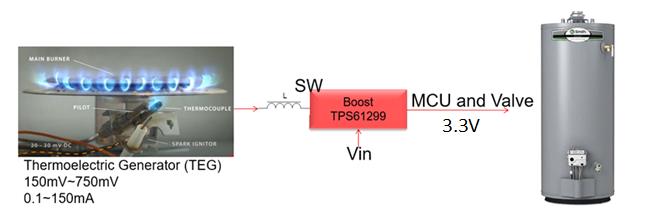SLVAFL5 September 2023 TPS61299
- 1
- Abstract
- Trademarks
- 1Introduction of Water Heater
- 2Low Voltage Start-up Boost Converter Introduction
- 3TPS61299 Ultra-low Voltage Start-up Design
- 4Ultra-low Voltage Start-up Design
- 5Summary
- 6References
1 Introduction of Water Heater
In some energy harvesting applications, the voltage of the input source as low as 150 mV, thus a boost is needed to regulate a higher voltage for the system. Water heater is just a good example: When the water heater is switched on, piezo ceramic fires, a small fire occurs to raise the temperature of the thermocouple, this time due to the temperature difference at both terminals. The thermocouple begins to generate a thermal potential (as low as 150 mV) , acting as the input to the boost converter, which regulates the output to 3.3 V to turn on the control portion of the water heater, as is shown in Figure 1-1. However, it is hard for a boost to start up within a ultra low input voltage and the UVLO of most boost device is 1.8 V or 0.7 V. let along 150 mV. This application note provides a solution using TPS61299 to support the 150 mV ultra low input voltage system.
 Figure 1-1 Water Heater Control
Diagram
Figure 1-1 Water Heater Control
Diagram